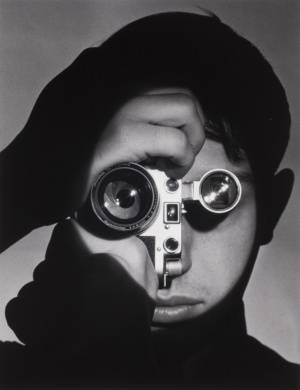Difference between revisions of "Andreas Feininger"
Jump to navigation
Jump to search
Sorindanut (talk | contribs) (→Works) |
m (Text replacement - "[[Category:" to "[[Series:") |
||
| (5 intermediate revisions by the same user not shown) | |||
| Line 1: | Line 1: | ||
| − | ''' | + | [[File:Andreas_Feininger,_The_Photojournalist,_1951.jpg|thumb|300px|''The Photojournalist'', 1951.]] |
| + | '''Andreas Bernhard Lyonel Feininger''' (27 December 1906 – 18 February 1999) was an American photographer and a writer on photographic technique. He was the son of the painter [[Lyonel Feininger]], studied cabinetmaking and architecture at the [[Bauhaus]] and established a Swedish firm specializing in architectural and industrial photography. He immigrated to New York City and became a staff photographer for ''Life'' magazine. The most famous photo of Feininger is ''The Photojournalist'', depicting [[Dennis Stock]] and published in ''Life'' in 1951. | ||
| − | + | ; Catalogues | |
| − | [[ | + | * ''[[Media:Andreas_Feininger_1906-1999_2007.pdf|Andreas Feininger (1906-1999)]]'', Madrid: Fundación Juan March, 2007, 134 pp. [http://www.march.es/arte/catalogos/ficha.aspx?p0=cat:160&p1=178&l=2] {{es}}/{{en}} |
| − | |||
| − | + | ; Links | |
| − | * [http://en.wikipedia.org/wiki/Andreas_Feininger | + | * [http://en.wikipedia.org/wiki/Andreas_Feininger Feininger at Wikipedia] |
| − | [[ | + | [[Series:Photography|Feininger, Andreas]] |
Latest revision as of 13:42, 3 December 2022
Andreas Bernhard Lyonel Feininger (27 December 1906 – 18 February 1999) was an American photographer and a writer on photographic technique. He was the son of the painter Lyonel Feininger, studied cabinetmaking and architecture at the Bauhaus and established a Swedish firm specializing in architectural and industrial photography. He immigrated to New York City and became a staff photographer for Life magazine. The most famous photo of Feininger is The Photojournalist, depicting Dennis Stock and published in Life in 1951.
- Catalogues
- Andreas Feininger (1906-1999), Madrid: Fundación Juan March, 2007, 134 pp. [1] (Spanish)/(English)
- Links
